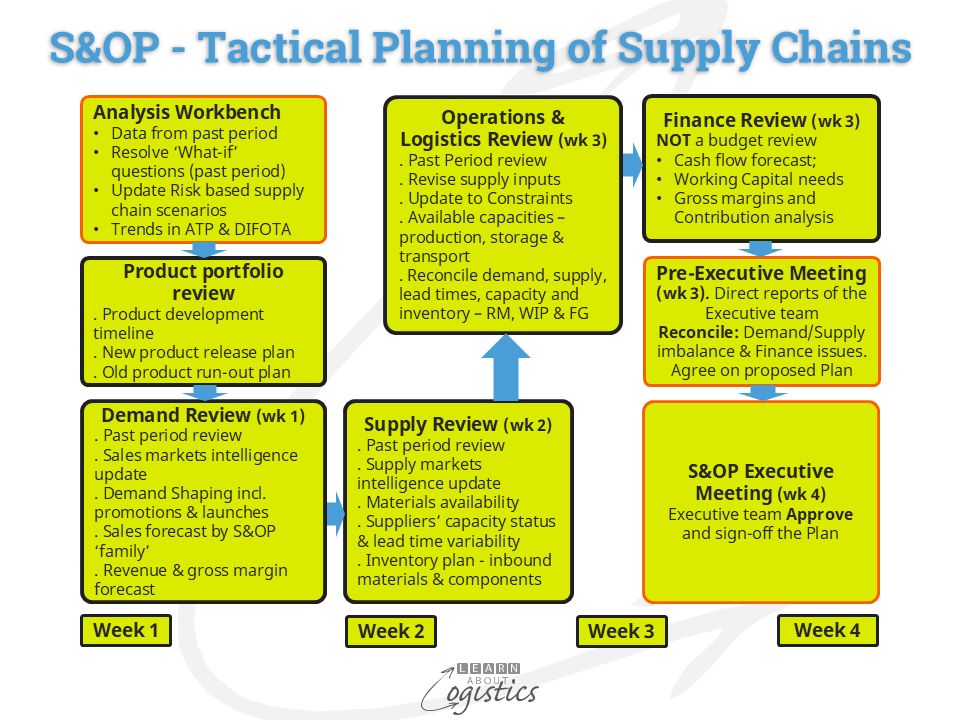S&OP flow in your business
Sales & Operations Planning (S&OP) is not a difficult process to follow – the challenge is to make it happen! The objective is to improve the balance through supply chains, between expected future demands for the organisation’s products and services, the organisation’s resources and the supply of purchased or intra-company provided items. And, of course, how the output from S&OP will be financed.
The previous blogpost was a call to supply chain professionals that the concept is under a potential threat of takeover by Finance. This can be achieved by Finance assuming responsibility for the S&OP process, as many businesses have yet to implement the concept. But, the absence of a strong S&OP process provides an opportunity for supply chain professionals to sell the planning concept to their senior management.
S&OP is required for organisations that make and or distribute products. S&OP is applicable for any operational business within a supply chain; for example: importers, outsourced or contract out operations, logistics service providers (LSPs), a loading terminal for commodities or a shipping container park.
The diagram below provides an outline structure of the S&OP process:

A structured process for planning
Sales & Operations Plan (S&OP) balances the forecast demand for products with the available supply, resources and capacity. The S&OP output is ‘owned’ by the senior management team within a strategic business unit (SBU), with profit responsibility; but, the process is managed by the Supply Chains group and facilitated by Operations Planning. When structuring your S&OP implementation plan, the main features to consider are:
- Products (stock keeping unit or SKUs) are aggregated into ‘families’. The number of families varies between 5 and 15 (preferably in a range of 6–12)
- Defining a ‘family’ of products can be derived from:
- the supply chains calculated from the Coefficient of Variance (CoV). A ‘family’ may also reflect specific capacity and capabilities of resources within ‘Operations:
- products supplied to major customers, such as supplying components to automotive assemblers
- a group of service parts
- products with high risk or deemed as critical
- the supply chains calculated from the Coefficient of Variance (CoV). A ‘family’ may also reflect specific capacity and capabilities of resources within ‘Operations:
- For each SKU, enable the Bill of Materials (BOM) within the ERP system to ‘roll-up’ to their S&OP ‘family’
- A standard unit of measure is used for both ‘Sales’ and ‘Operations’ e.g. shippers (the carton size shipped to customers), tonnes, litres, pallets, hours etc. Note: The Demand Plan is likely to use a standard unit of measure that converts the selling units to the Demand Plan unit of measure
- S&OP provides a focus on planning the tactical horizon over a forward period from month 3 out to 18 or 24 months. Planning is by month between three and six months, then quarterly to month 12 and half yearly to the horizon used for planning. The current and next month are the ‘freeze’ period for Operations, addressed by the operational schedule, so are not considered in S&OP
- S&OP reviews are by product ‘family’, using the standard unit of measure. This provides a consistent communication base across all functions and entities
- The S&OP process cycle is typically monthly. However, to obtain consistency of measurements and ease of comparison, consider 13 x 4 week periods per year
- Inventory of products is described by form and function for each family at Nodes in the outbound supply network
- Sales forecasts commence with each SKU (recognising product returns and credit notes), however the variability of sales by SKU means that an increasingly lower proportion of SKUs can be forecast based on a normal distribution of data. Identify sales by group and class using Coefficient of Variance (CoV)
- Provide an optimistic and pessimistic forecast of each SKU, weighted by their probability. Include a sales variance of (say) +/- 5 percent from the weighted forecast. Sales forecasts are then consolidated into their product group in the Demand Plan. This Plan is uploaded to the Master Schedule (MPS), using the Rough Cut Capacity Plan (RCCP) function, used as the planning base by each S&OP ‘family’. Forecasts are also summarised by market segment/territory and Strategic Business Unit (SBU) totals
- Implement a disciplined ‘product life-cycle’ process, concerning new and updated product releases and end of life
Responsibilities in S&OP
Although the S&OP process is done at each Strategic Business Units (SBU) of a business, the inter-relationships of SBUs within the enterprise must be identified – global planning authority; region responsibility; matrix organisations (local operations and region/global services) etc. The SBUs must have a common approach to S&OP, to ensure that numbers mean the same throughout the organisation. This includes a common definition for demand, supply and planning elements.
Each SBU manager, being responsible for their part of the corporate P&L, is a critical part of S&OP. Their role in the implementation of S&OP includes gaining the support of their management group for the concept and process, which includes issues concerned with perceived power and status by managers. The P&L manager needs to initially ensure a ‘balance’ between the inputs to the process by ‘Sales’ and ‘Operations’ and the other functions, as they learn what is required from collaboration.
The P&L manager authors the S&OP policy document, which can be modified from the corporate version to recognise variations within the SBU. The document includes:
- an overview of the process and its objectives concerning future actions and anticipated results;
- the participants in the process and their responsibilities (e.g. those who are responsible or accountable; consulted or informed);
- the expected outcomes from each step through the planning cycle and
- the S&OP meeting dates and times over the next 12 months
There are two parts for each meeting. The first (and shortest) part is a review of recent performance and lessons learnt (called the past period review). The second and longer part of the meeting is the intended plans and actions to meet future customer demands, set against the most likely internal capacity and capabilities.
For each meeting shown in the diagram above, the target time is not more than one hour. To assist this objective, meetings should be held late in the afternoon. It can take the first three meetings, with a strong personality as chair, for attendees to understand the one hour rule.
Because S&OP is the tactical planning process for the organisation’s supply chains, it is the Supply Chains group which has responsibility for guiding the process. Specifically, the Master (or senior) Planner of each SBU is responsible for facilitating and reconciling the completion of the steps in the process.
S&OP is not a ‘software driven’ process. However, to be effective, the S&OP process requires factual input from all parts of the organisation, so accuracy and timeliness of relevant data and information is required. Over time, a simulation application can be used, typically at the pre-executive meeting stage, to model the impact of alternative plans against constraints in supply and demand markets and the business.
Towards collaboration
S&OP is a long-term project, which should show some initial benefits within six months. However, to be successful requires changes in attitudes about working in teams and how ‘success’ is measured at all levels of management – it is about collaboration.
It takes time to change the culture in an organisation. For collaboration to become embedded in the organisation through the S&OP process and beyond could take up to three years. The challenge will be a willingness to work at improving the process (and results) over this length of time. The time is required to:
- build an education process for affected staff, both current and replacement;
- implement revised processes;
- new performance measurements (metrics) to be developed, used and understood and
- for IT enhancements to be proposed, tested, purchased and implemented
The updated S&OP by each ‘family’ is an input to the Supply & Operation Execution (S&OE) process. This commences with the S&OP converted back to SKUs in the Master Schedule (or similar term) in the ERP system. The Master Schedule is the driver for plans concerning inbound supplier items, production and delivery plans and schedules. To reduce uncertainty in supply chains, the ideal situation is for an organisation’s Master Schedule to become an input to the Tier 1 suppliers’ S&OP process and those suppliers to then do the same for their suppliers. So, collaboration can eventually be extended to suppliers.
This and the previous blogpost provide an overview of the ‘why’ and ‘how’ of S&OP. Use the document to sell the concept and help make it happen. Assistance from S&OP experienced consultants and software suppliers may help, but be careful of those that put their own ‘badge’ on the process by renaming S&OP as ‘Sales, Operations and Inventory Planning’ or ‘Sales and Inventory Optimisation Planning’ etc.

